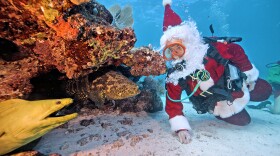A thirty-five-pound green sea turtle named Haven that spent the last six months in rehab at The Turtle Hospital in Marathon, Florida, finally got her chance to go home Friday.
The 8-year-old endangered green sea turtle spent the last six months rehabilitating at The Turtle Hospital after being rescued, wrapped in fishing line and covered in fibropapilloma tumors. Following months of rehab, laser treatment, and cancer-fighting eye drops, Haven was declared healthy and ready to return to the sea.
Haven took her time at her release on Friday, at a crowded Sombrero Beach in Marathon while marking her entry as the only rehabilitated and only juvenile in this year’s Sea Turtle Conservancy’s Tour de Turtles event.
Participants in this “race” are typically nesting female adults that migrate several thousand miles over the course of three months from August to October – proving endurance matters more than speed. However, the satellite tracking continues for about a year, which is when the transmitters typically fall off. Sea Turtle Conservancy Communications Coordinator Lexie Beach says that juveniles are “laid back” in comparison.
“We don’t expect them to migrate far distances, so they hang around the Keys and they’re feeding on seagrass, on jellyfish,” she says. “We anticipate Haven will stick close to home and probably just travel maybe a couple hundred miles.”
The turtles are equipped with a small satellite transmitter attached by a special epoxy to the tops of their carapaces.
“Every time she surfaces, that satellite transmitter will send a ping, and it will update either on the Tour de Turtles website or our STC Sea Turtle Tracker app,” says Beach.
Haven was rehabilitated at The Turtle Hospital, which has released more than 3,000 sea turtles since its founding as Florida’s first licensed turtle rehab facility in 1986 by Richie Moretti.
“We’re especially interested to see how her migration pattern and her behaviors might differ from the wild adult nesting turtles that we’re tracking,” says Beach.
The satellite-monitored journey gives researchers valuable data about the migratory patterns of sea turtles while raising awareness about the threats they face. The public can follow each of the turtle entries and root for their favorite by visiting TourdeTurtles.org.












